These AP 9th Class Social Studies Important Questions 7th Lesson Industries in India will help students prepare well for the exams.
AP State Syllabus 9th Class Social 7th Lesson Important Questions and Answers Industries in India
9th Class Social 7th Lesson Industries in India 1 Mark Important Questions and Answers
Question 1.
Study the map given below and answer the following question. (SA-II : 2018-19)
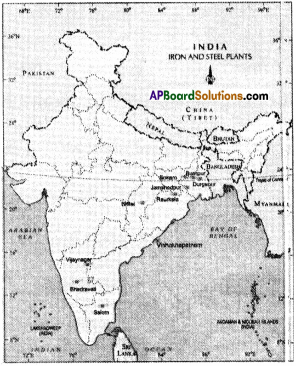
Q : Where in Karnataka are the steel plants located?
Answer:
Vijayanagar and Bhadravathi are the two places has steel plants in Karnataka.
9th Class Social 7th Lesson Industries in India 2 Marks Important Questions and Answers
Question 1.
Draw a bargraph based on the given information. (SA-III : 2015-16)
| Year | Production of cement (In million tonnes) |
| 1970 – 71 | 25 |
| 1980 – 81 | 50 |
| 1990 – 91 | 100 |
| 2000 – 01 | 150 |
| 2010-11 | 210 |
Answer:

Question 2.
The pie charts below show the percentage of people employed in Agriculture. Industry and service sectors. Read the pie charts carefully to answer the question.
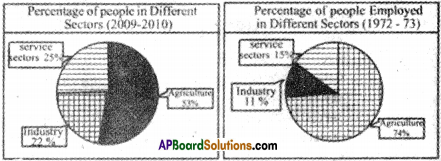
How did the pattern of employment change between 1972-73 and 2009-2010? (SA-II : 2018-19)
Answer:
- The employment generation in agricultural sector has been decreased from 74% in 1972-73 to 53% in 2009-10.
- The employment generation in industrial sector has been increased from 11% in 1972-73 to 22% in 2009-10.
- The employment generation in service sector has shown an increase of 10%.
9th Class Social 7th Lesson Industries in India 4 Marks Important Questions and Answers
Question 1.
Observe the ‘Pie Chart’ and answer the following questions. (SA-III : 2015-16)
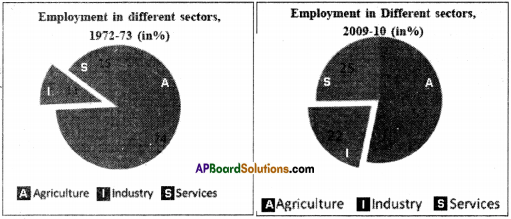
Answer the following Questions.
1. What does the above given graph denotes?
2. What is the percentage of change in employment by industry when compare between 1972-73 and 2009-10?
3. Which sector generated highest employment in 2009-10?
4. Write any two occupations regarding service sector?
Answer:
- The above graph explains % of employment in different sectors.
- From 1972-73 to 20019-10 the change in employment in Industrial sector is from 11% to 22%.
- Agricultural sector.
- Doctor, lawyer, teacher, banking, commerce, communications etc. are the occupations in the sector.
![]()
Question 2.
“Industries are necessary for the development of a nation. It is also fact that industrial activities are increasing environmental problems” – Write your opinions on this matter in detail. (SA-III : 2016-17)
Answer:
Industries are necesary for the development of a nation by the following ways.
- When goods made in factories and exported to other countries, we get revenue.
- A few decades before, three-fourths of income from goods exported from manufacturing industries alone.
- Even today, nearly two-third of goods exports is contributed by industries and particularly small industries.
- Factory goods exported range from gems, jewellery, chemicals, cars, machinery, cashewnuts, etc.
- The money or foreign exchange earned in this process enable us to import from other countries a large number of goods that we want from other countries.
At the same time industrial activities are increasing environmental pollution by the following ways.
- The production process in industries involves the use of electricity and application of different chemicals.
- In the course of production, these industries release a lot of other materials. They are causing pollution in the industrial locations.
- The industrialization led to the indiscriminate exploitation of minerals, forests, soils, air, etc.
- It leads to deforestation and damages the natural habitat of animals.
- Underground water is being contaminated due to the release of wastes by the industries.
- Some animals are endangered and some creatures have become extinct.
- The depletion of ozone layer, pollution of water, air, soil has increased ecological problems.
Question 3.
Mixing of some poisonous substances in air, water and soil causes to ‘ecological crisis’ – give your suggestions to prevent this problems as a student. (SA-II : 2017-18)
Answer:
Pollution prevention is a major global concern because of the harmful effects of pollution on a person’s health and on the environment.
Suggestions:
- Stop smoking or at least follow the “No smoking” sign.
- Never use open fires to dispose of wastes.
- Instead of using your cars, choose to walk or ride a bicycle whenever possible.
- Adopt the BRs. of solid waste management, reduce, reuse and recycle.
- Use eco-friendly or biodegradable materials instead of plastic.
- Do not cause loud noises and unwanted sounds to avoid noise pollution.
- Industries should use fuel with lower sulphur content.
- Industries should strictly follow applicable government regulations on pollution control.
Conclusion :
Breathing is life. We know that we will survive without food for several weeks and without water for few days, but without oxygen, we will die in a matter of minutes.
The oxygen, the air we breathe sustains us. So, let us make today and every day a good day for everyone.
Question 4.

Read the above pie chart and answer the following questions. (SA-II : 2017-18)
1. What does the pie chart tell us?
2. Which sector provide the highest percentage of employment?
3. In which sector employment increased twice?
4. By 2009-10 which sector was the second piace in empioyment?
Answer:
- Pie chart tells us the percentage of employment in different sectors from 1972-73 to 2009-10 years.
- Agriculture sector provide highest percentage of employment.
- In Industrial sector employment increased twice.
- By 2009-10, the services sector is in second place in employment.
![]()
Question 5.
When people buy groceries, they may have their groceries packed in plastic bags, paper bags, or cloth bags they bring with them.
Which type of grocery bag is the best to help protect the environment?
a) Plastic
b) Paper
c) Cloth
Explain in what way your choice of bag can help protect the environment.
Answer:
- My choice is paper bag and cloth bag. Both are best to use.
- We should not use plastic bags as they are threat to environment.
- Plastic bags are not eco – friendly: They won’t decompose quickly, if you burn them also it will take time to mix with soil.
- Recently in Vijayawada, some areas of the city drowned in rainwater because all the sewage drains were filled with bunches of plastic bags.
- But paper and cloth bags will decompose in very short period and completely eco friendly.
- Paper bags made by wood pulp it may cause deforestation.
- Cloth bags made of cotton, quickly it decomposes.
9th Class Social 7th Lesson Industries in India Important Questions and Answers
Question 1.
Why are the infrastructure facilities important in establishing industries?
Answer:
- Building of roads, good transport facilities, power supply and telephone connections, etc. can be termed as infrastructural facilities.
- Factories need raw materials. These raw materials are to be transported to the factory sites. Hence good road ways and other facilities are needed.
- Factories need power to run machines. Hence all infrastructure facilities are needed.
![]()
Question 2.
Why are industries important?
Answer:
In industrial sector, the raw materials are worked upon by people and changed using tools and machines to produce a good that can be useful.
The importance of industries :
i) Industries provide a wide range of products :
There are plenty of goods made in factories. Ranging from paper and other stationery, fridges to cars, batteries, bulbs and other electrical appliances.
ii) Industries are expected to employ a large section of people looking for jobs :
- Generating employment to work in factories is generally considered as one of the indicators of development and improvement of well being of people.
- Employment in industries has increased from 11% in 1972-73 to 22% in 2009-10.
iii) Industries are important source of export incomes:
- We earn a lot of foreign exchange by selling industrial goods to foreign countries.
- Even today, nearly two-thirds of goods exported is contributed by industries.
![]()
Question 3.
What were the restrictions introduced by the government during the early years of industrialization?
Answer:
- Many industrial activities were allowed only for small producers. For example, production of cloth of specific quality was restricted to handlooms.
- Government made laws so that the large factory owners get prior permission or license to set up factories. This was done so that there would be better planning.
- The government regulated the quantity of goods produced by factories.
- The price at which they can be sold was also fixed.
All these restrictions were introduced keeping in view the welfare of the people.
Question 4.
Industrial policies of the early years became hindrance to the growth of industry. Explain.
Answer:
- Entrepreneurs were required to follow so many procedures and had to wait for many years to get the approval from the government offices.
- Licenses were not given to the most efficient producers.
- The selection was biased in favour of people with political connections and the economically powerful.
- All this discouraged new entrepreneurs who would work with latest technology available.
- Further control on prices led to shortage of goods. E.g.: Scooters.
- Such shortages were common for important basic goods like coal and cement, which in turn caused a lot of delay in production of other goods.
- Another problem was lack of quality of some of goods.
- There were restrictions on the import and export of industrial goods including machinery and raw materials.
- Prices were laid down by the government and the producers had to sell only at that price.
So the above restrictions acted as hindrance to the growth of industry.
![]()
Question 5.
Write about the impact of industrial policies.
Answer:
The following are the impacts of industrial policies of government.
i) Rise in the number of industrial units:
Today nearly 2 lakh large factories and 3 crore small factories are operating in India.
ii) Employment has increased but less than expected:
Both small and large scale employ nearly about one-fifth of India’s 460 million workers.
iii) Low salaries and less working conditions:
A large section of workers are employed in small units which generally pay very low salary and devoid of workers safety conditions and health benefits.
iv) Production of factory-based goods has increased:
Establishment of basic industries resulted in increased production of factory based goods.
- The production of coal and lignite has increased from 32 million tons in 1950-51 to 571 million tons in 2010-11.
- The production of steel has increased from 10 million tones in 1980-81 to 70 million tons in 2010-11.
- There was also a significant increase in the production of crude oil and cement etc.
v) Increase in environmental problems, land conflicts and pollution:
These industries release a lot of waste materials into the atmosphere and into the tanks and wells causing lots of air pollution and damaging water resources. The air pollution is causing skin diseases and respiratory diseases.
Question 6.
At the time of independence what were the objectives that were desired to be achieved through industrialization?
Answer:
- After 1947, India began many initiatives to promote industrial activities in the country.
- Major objectives were – to become self-sufficient in meeting our needs and to make the country an industrially developed nation.
Question 7.
Where should the sugar and jaggery mills be ideally located?
Answer:
The sugar and jaggery milis should be ideally located near the crop grown areas.
![]()
Question 8.
Where would it be economically viable to set up the cement manufacturing units?
Answer:
Cement manufacturing units can be established near the areas where the raw materials are available in bulk.
Raw materials :
Limestone, silica, alumina, gypsum, coal and electric power and transportation facilities.
Question 9.
Name the important centres of cotton textiles in Gujarat.
Answer:
Ahmedabad, Vadodara, Surat, Rajkot and Porbandar.
Question 10.
Where are the silk textile industries located in Jammu and Kashmir?
Answer:
In Baramula, Srinagar and Anantanag.
Question 11.
What are the basic requirements of industrialization?
Answser:
- Industrialization means to develop a large number of different factories.
- For industrialization, we have certain basic requirements.
- They are machines, electricity, minerals and ores and transport facilities.
![]()
Question 12.
What factors influence the selection of an industrial location?
Answer:
- Industrial locations are complex in nature.
- These are influenced by raw material labour, capital, power, and market, etc.
- It is rarely possible to find all these factors available at one place.
- So industries are located where these factors even can be arranged at lower cost.
Question 13.
What is an agrobased industry?
Answer:
The industries which are based on agricultural products are called ‘agrobased industries’.
Question 14.
Why do you think cotton textile industry is concentrated in Maharashtra and Gujarat?
Answer:
- Many factors support the concentration of cotton textile industry in Maharashtra and Gujarat.
- Availability of raw cotton, market, transport including accessible port facilities, moist climate etc. are some factors.
- Apart from these, availability of abundunt electricity at cheap prices and availability of skilled and unskilled labour in abundance add to those factors.
- These places also have investment supports from Banks and international market demands.
- Above factors help the flourishing of cotton textile industry in Maharashtra and Gujarat.
![]()
Question 15.
Read the following passage and answer the questions given below.
| Challenges faced by the industry include stiff competition in the international market from synthetic substitutes and from other competitors like Bangladesh, Brazil, Philippines, Egypt and Thailand. However, the internal demand has been on the increase due to the Government policy of mandatory use of jute packaging. To stimulate demand, the products need to be diversified. In 2005, National Jute Policy was formulated with the objective of increasing production, improving quality, ensuring good prices to the jute farmers and enhancing the yield per hectare. The main markets are U.S.A., Canada, Russia, United Arab Republic, U.K. and Australia. The growing global concern for environment friendly, biodegradable materials, has once again opened the opportunity for jute products. |
1) What is the industry mentioned in the above passage?
Answer:
Jute industry.
2) What are the challenges faced by the industry?
Answer:
Challenges faced by the industry include stiff competition in the international market from synthetic substitutes and from other competitors like Bangladesh, Brazil, Philippines, Egypt and Thailand.
3) When was National Jute Policy formulated?
Answer:
In 2005.
4) Name the main markets mentioned in the passage.
Answer:
USA, Canada, Russia, United Arab Republic, UK and Australia.
5) To stimulate demand, the products need to be
Answer:
diversified.
Question 16.
Discuss what is meant by the word “basic”? What are the basic necessities for industries?
Answer:
- “Basic” means the things that are basically necessary.
- The basic necessities for setting up any industries are machines, electricity, minerals and ores and infrastructural facilities like transport, telephone, etc.
Question 17.
Today West Bengal is the dominant state in Jute Industry. How is it able to become like that?
Answer:
- Most Jute mills in India are in West Bengal, mainly along the banks of the Hugli river 98 km long and 3 km wide.
- Hugli basin is in proximity of Jute producing areas, inexpensive water transport, supported by a good network of railways, roadways and waterways to facilitate movement of raw materials to mills.
- Abundant water for processing of raw jute, cheap labour from West Bengal, Bihar, Odisha and Uttar Pradesh.
- Kolkata provides banking, insurance and port facilities for export of jute goods.
- It provides direct or indirect employment to more than 40 lakh people.
![]()
Question 18.
Name the problems that are faced in the Iron and Steel industry?
Answer:
- It needs huge capital investment, which is difficult for developing country India.
- Indian technology is now far behind the advanced countries.
- Low per capita productivity and low potential utilization are to be addressed.
- Even at a low per capita consumption, demand for our production is not sufficient.
- Now we are importing iron and steel by spending precious foreign exchange.
- All the above problems needed to be solved.
Question 19.
Locate the following industrial cities on the outline map of India. City
| City | Industries Concentrated |
| Jamshedpur | Iron and Steel company |
| Ahmedabad | Textile industry |
| Mumbai | Textile, oil refinery, fertilizers, etc. |
| Visakhapatnam | BHPV, Steel Plant, Ship building, etc. |
| Chennai | Cement, Cotton, Railway coaches, etc. |
| Rourkela | Iron and Steel industry |
| Kanpur | Leather industry |
| Madurai | Cotton textile industry |
| Luduiana | Leather industry |
| Varanasi | Diesel locomotives |
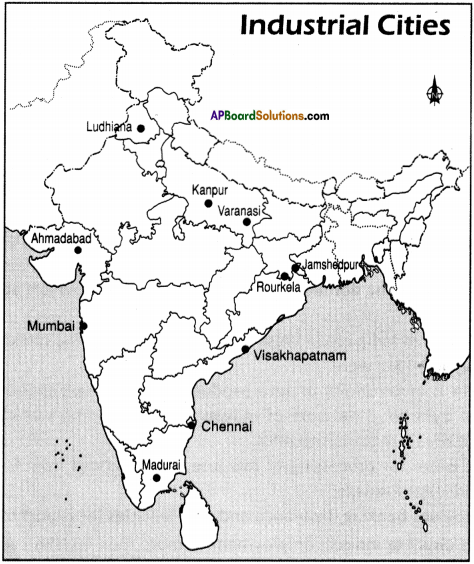
Question 20.
Observe the following map and answer the questions given below.

1) Where do you find both cotton and woollen textiles?
Answer:
In Ahmedabad and Kanpur.
2) What is the South India state famous for silk textiles?
Answer:
Karnataka.
3) Name the important centres of cotton textiles in Gujarat.
Answer:
Ahmedabad, Vadodara, Surat, Rajkot and Porbandar.
4) Which type of textile industries are in major position in Maharashtra?
Answer:
Cotton textile industries.
5) Where are the silk textile industries located in Jammu and Kashmir?
AIn Baramula, Srinagar and Anantanag.
Question 21.
Observe the following map.
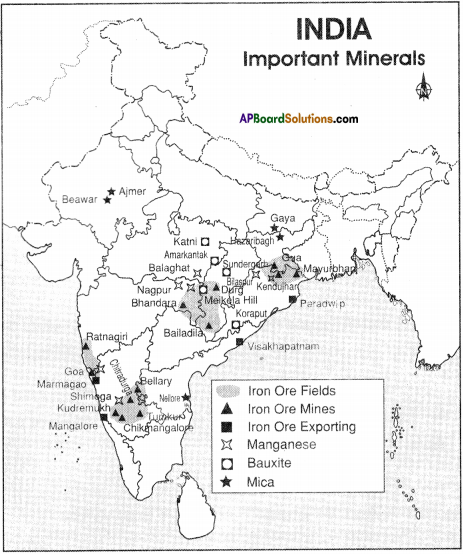
Now answer the questions given below.
1) What are the minerals mentioned in the map?
Answer:
Iron ore, manganese, bauxite and mica.
2) In which states do you find iron ore mines?
Answrr:
Maharashtra, Karnataka, Odisha and Chattisgarh.
3) What are the iron ore ex-porting ports mentioned in the map?
Answer:Visakhapatnam, Managalore, Marmagao and Paradwip.
4) Where can we find mica in Andhra Pradesh?
Answer:
In Nellore.
5) What is the mineral found in Rajasthan?
A. Mica.
Question 22.
Observe the following map.
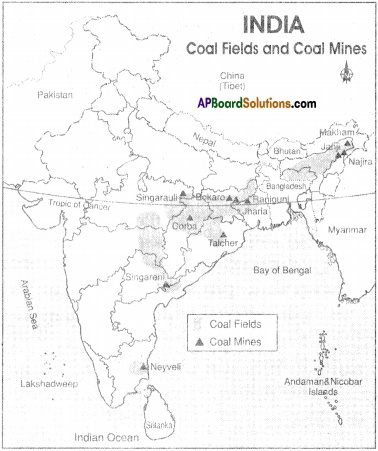
Now answer the questions given below.
1) Which state is Raniganj coal mine located in?
Answer:
West Bengal
2) Where is the coal field located in Tamilnadu?
Answer:
Neyveli
3) Name the important coal mine of Telangana.
Answer:
Singareni
4) What is the coa! field that belongs to Chattisgarh?
Answer:
Korba
Question 23.
What steps are to be taken to reduce the problems of pollution?
Answer:
- We should stop effluent flow into water bodies.
- Provide safety drinking wafer to the affected villages.
- Continuous vigilance in discharge of effluents.
- Medical care to pollution victims.
- Cancellation of licence to pollution causing industries.
Question 24.
What measures would you suggest to overcome the problems of Textile Industry?
Answer:
- Care should be taken to increase the supply of raw material.
- Obsolute machinery which resulting in low productivity and inferior quality should be replaced.
- Government should provide adequate power to textile industry.
- Care should be taken that textile industry shall not lost in the stiff competition with power loom and synthetic fiber products.
- Many textile mills are sick, government should help them run properly.
![]()
Question 25.
What suggestions would you make to improve jute industry?
Answer:
- The best way to solve the problems of jute industry is to increase production.
- There is an urgent need to replace the old machinery.
- Jute mills are needed to be modernized.
- New Jute products are to be developed.
- The product range of jute is to be diversified.
